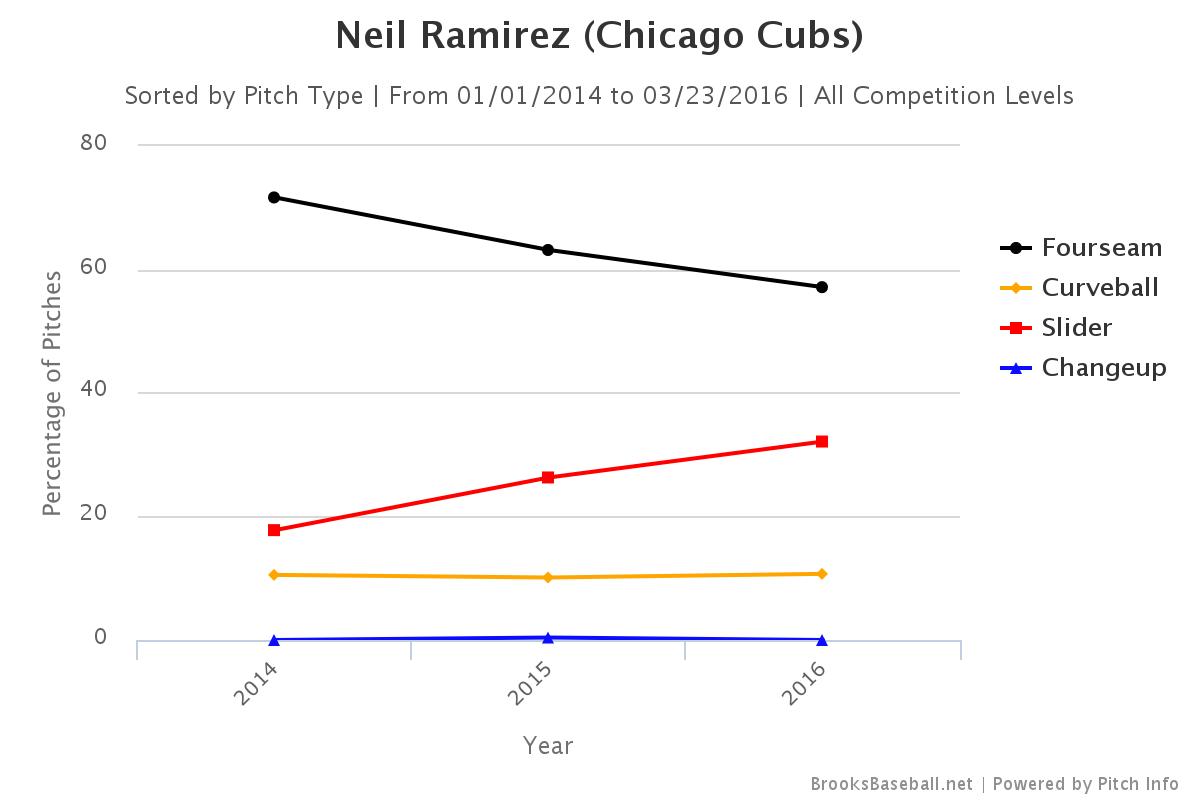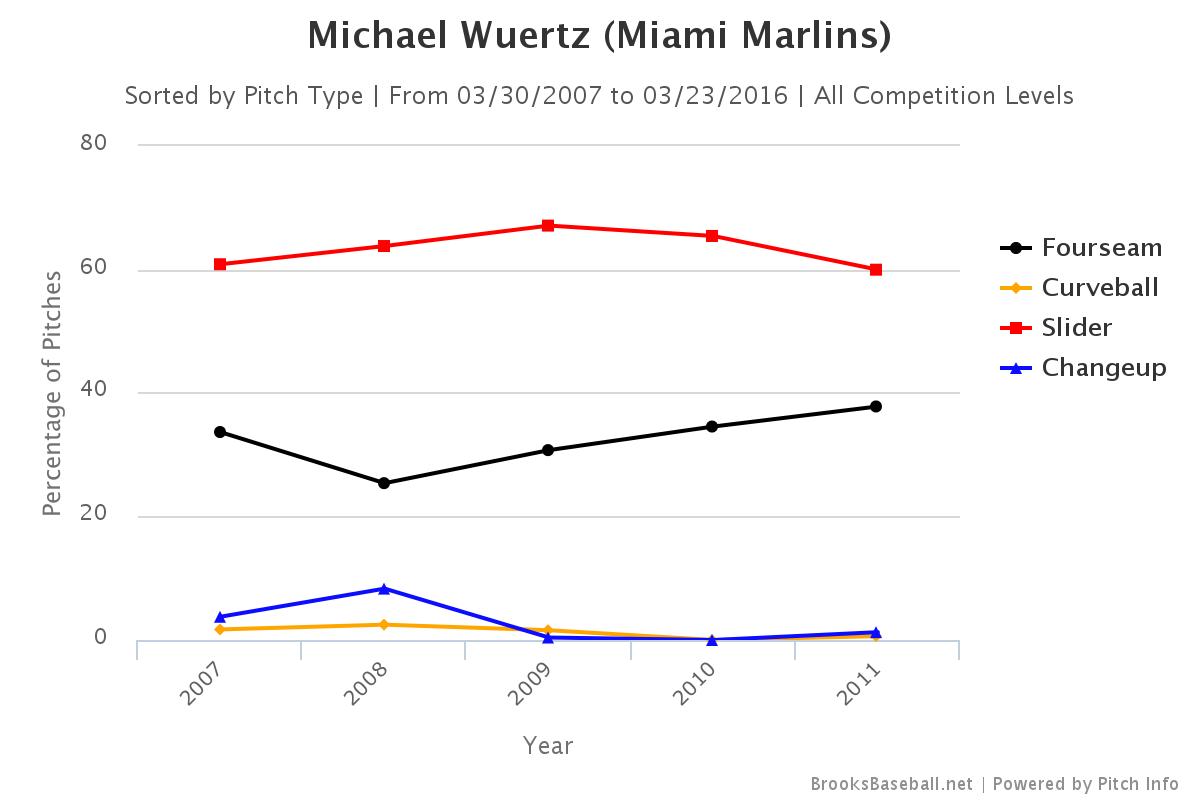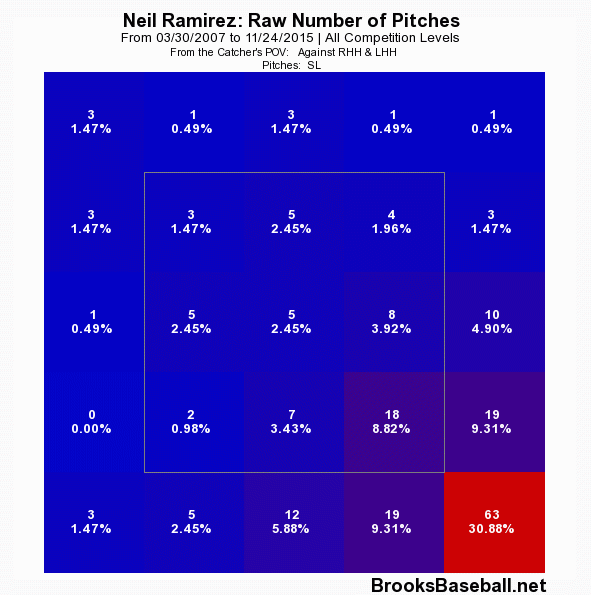The Cubs have a Neil Ramirez problem. After crushing the competition in 2014, to the tune of 43 2/3 innings pitched, a 1.44 ERA, 2.61 FIP, and 10.9 K/9 with 3.5 BB/9, Ramirez fell off in 2015 due to problems with his throwing shoulder. His average fastball velocity, which was 95.4 MPH in 2014, dropped to just 93.6 MPH in only 14 innings of work in 2015. With an offseason of rest and coming into spring training fully healthy, the hope was that everything would be just fine and Ramirez would go back to being something close to what he was two seasons ago.
So far, not so good. Ramirez’s velocity is still down, hitting just 93.2 MPH on the fastball. The odd part is that his slider, which was electric at 87.9 MPH in 2014 and slipped a bit to 85.5 MPH in 2015, has dipped all the way down to 83.9 MPH. Even though Ramirez was able to get guys out and cover his drop in velocity in his small sample of innings he threw last year—he had a 3.21 ERA with 9.6 K/9 and 3.7 BB/9 in those 14 innings—it’s hard to see him continuing to have success using his fastball as his primary pitch without either bringing a bit more heat or developing another decent pitch.
Not that spring training stats mean a ton, or anything, but Ramirez was rocked hard the other day—allowing three hits, a walk, and five earned runs without getting a single batter out against the Cleveland Indians. On the spring, Ramirez has allowed seven hits, seven earned runs, and a walk to go along with four strikeouts in his four total innings of work. For a guy that the Cubs would love to see earn a place in the bullpen, it’s about as bad of a spot as he could be.
Which is for two reasons. First, Ramirez is out of options and can’t be sent down to Triple-A, and second, because he’s not injured. The MLBPA frowns upon teams placing players in the disabled list at the end of spring training just to hide them and not expose them to the waiver process, and the Cubs front office would need to think long and hard about handling his situation in that manner.
There still is reason to hope for Ramirez, and that’s because 93 MPH on a fastball—if you have another good secondary pitch, like his slider—is still good enough velocity. When Ramirez came back up with the Cubs last September, he was pitching with confidence and getting batters out despite not being able to turn up the heat like in the past. He threw 5 1/3 innings, allowing two hits, one walk, two earned runs, and striking out six batters. All of that, while averaging 93.6 MPH on his fastball.
At the time, you’ll recall, there was even discussion of whether Ramirez might be auditioning for a spot on the playoff roster, according to Mark Gonzales of the Chicago Tribune:
“I feel really confident in where I am and where I need to be,” Ramirez said. “The velocity will come as I get out there more. It’s one of those weird years where there’s been so much up and down, but I still feel, even when I’m throwing 93 mph, my fastball has good life and it’s different than it was before.”
While it’s tempting to dream on the Neil Ramirez that looked like a fire-spitting set-up man as recent as 18 months ago, we need to accept that the 95-96 MPH fastball may never be coming back. Can Ramirez be a good reliever if he’s hitting just 93 MPH regularly?
I pondered that thought for a few days, thinking of a pitcher with similar stuff that has had success. The best comparison that I can find for Ramirez is former Cubs reliever Michael Wuertz. The players are somewhat similar, in that they both feature a four-seam fastball, a slider, a changeup, and a curveball, but throw primarily the fastball and slider. Wuertz threw his fastball around 91-92 MPH and the slider about 85-86, which is pretty close to what we’re seeing from Ramirez. It’s interesting enough to at least pursue this angle, I think.
Where the two pitchers differ, however, is in pitch usage. Ramirez likes to throw his fastball quite a bit, but Wuertz was fairly well known as being a slider-thrower. Observe the differences, in line graph form:
Interestingly enough, when you look at results on pitches, both players saw the lowest batting average and slugging percentage against their sliders—with batters hitting .094 and slugging .170 against Ramirez’s slider and .199/.309 against Wuertz’s. Carlos Portocarrero wrote the player profile on Ramirez last December, making some excellent points on Neil’s filthy slider:
“Ramirez featured a sterling 30 percent strikeout rate in 2014, and a lot of that had to do with how he used his slider. Check out this table from Brooks Baseball:
It’s pretty clear that he uses this as a wipeout pitch against righties, and without that hard fastball to keep hitters honest, it loses its effectiveness.”
Thinking outside the box to solve this problem, it makes me wonder if Ramirez could reinvent himself a bit by throwing his slider as his primary pitch, and using his fastball as the secondary like Wuertz used to do. Like Wuertz, Ramirez has good movement on the pitch and throws it relatively hard. It’s deceptive enough that sneaking in a 93 MPH four-seamer every few pitches could be a winning combination.
The theory is intriguing, to say the least. For what it’s worth, Wuertz had a very nice stretch for the Cubs and the Oakland A’s throwing sliders all day, compiling 236 1/3 innings from 2006-2009 with 9.6 K/9, 3.6 BB/9, and a 3.08 ERA.
The Cubs haven’t committed, one way or the other, but many believe that they intend to carry eight pitchers in the bullpen on Opening Day in Los Angeles. That means Hector Rondon, Pedro Strop, Travis Wood, Adam Warren, Justin Grimm, Clayton Richard, and Trevor Cahill are sitting pretty, with one more open spot in the ‘pen. There is little competition other than Spencer Patton, who has looked good this spring with 12 strikeouts in 7 1/3 innings pitched. But Patton can still be optioned to Triple-A, and options sometimes are more important than spring performance, unfortunately.
Would it be worth placing Ramirez on waivers, and potentially losing him, to be able to keep Patton on the roster right now? For a role that is, more or less, mop-up duty? Does giving Ramirez one last shot to show he can still get hitters out cost you that much? I don’t think it does, even in a season where winning is the number one goal. It’s hard to argue that Patton coming into blowout-games in April is measurably better than Ramirez, all things considered.
I expect that the Cubs will figure it out, and with the start of the season just over a week away it’s possible Ramirez has a better showing in his final few appearances of the spring. But even if he doesn’t, it’s difficult to see the Cubs giving up on such a high-potential arm—even given the injury history—with such a small level of risk involved in giving him a few extra weeks on the roster.
Lead photo courtesy Mark J. Rebilas—USA Today Sports.




Man, we need Nails this year. Understand the odds are against a return to his top form/velo – but sure would be nice for him to partake in the riches he’s toiled for the past few years…